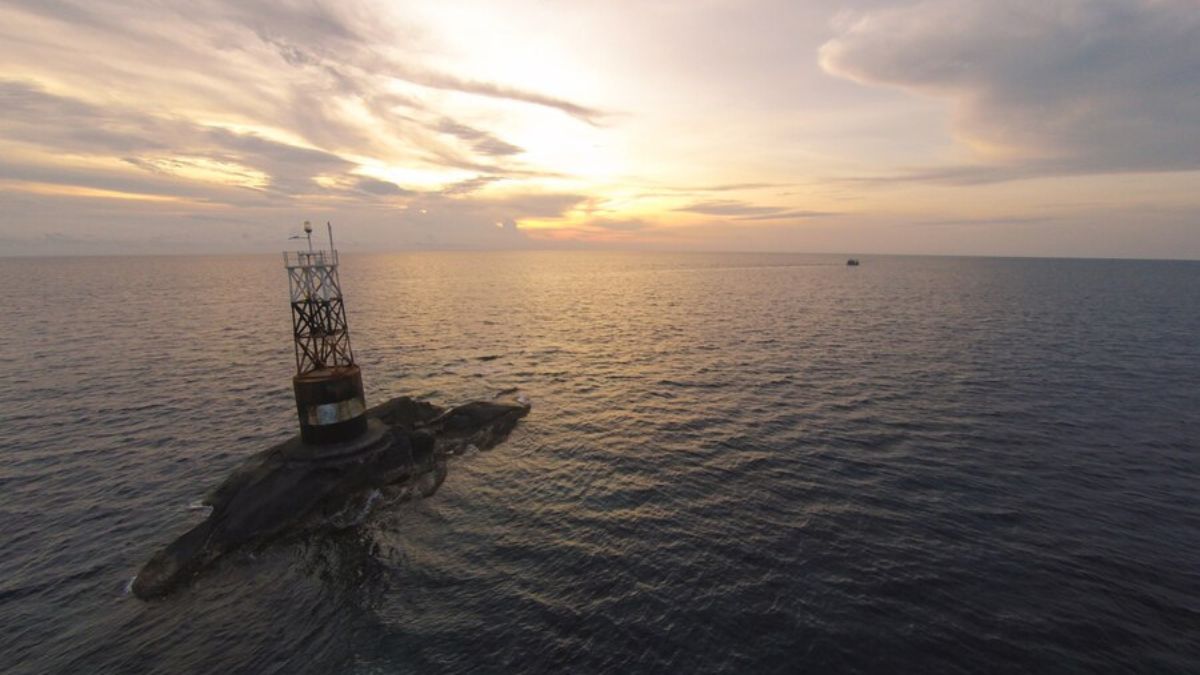TECHNOLOGY
Riding the Waves of Innovation Deep Offshore Technology’s Impact on Ocean Exploration

Introduction
Deep offshore technology is revolutionizing the way we explore and utilize the vast resources of our oceans. The deep seas, once considered the final frontier of human exploration, are now more accessible than ever, thanks to cutting-edge advancements in technology. This blog post will take you on a fascinating journey into the realm of deep offshore technology. We will explore how it is paving the way for new discoveries, enhancing resource extraction, and addressing environmental concerns. Whether you’re a student curious about oceanic possibilities or a professional in the maritime industry, you’re about to discover why deep offshore technology is making waves.
The Rise of Deep Offshore Technology
The concept of deep offshore technology might sound futuristic, but it has been developing steadily over the years. With increasing global demand for resources and the depletion of easily accessible reserves, the importance of tapping into the ocean’s depths is more relevant than ever. This technology encompasses a range of tools and systems designed to operate in the challenging environment of the deep sea, where pressure is immense and sunlight scarce. Countries all around the world are investing heavily in this field, recognizing its potential to drive economic growth and technological advancement.
Exploring the Depths The Need for Innovation
Exploring the ocean depths presents a unique set of challenges. Traditional technologies used in shallow waters are often insufficient due to the immense pressure and harsh conditions found deeper below. This has led to the development of innovative solutions, such as remotely operated vehicles (ROVs) and autonomous underwater vehicles (AUVs). These machines are equipped with the latest sensors and cameras, allowing researchers to explore marine life, geological formations, and potential resource deposits without putting human lives at risk.
Unveiling Hidden Resources
The ocean floor is a treasure trove of resources waiting to be discovered. From oil and gas to rare minerals, deep offshore technology allows us to access these resources efficiently and sustainably. Innovations like subsea production systems and drilling technologies have made it possible to extract oil and gas from miles beneath the ocean surface. Meanwhile, deep-sea mining is emerging as a viable method for obtaining valuable minerals, such as cobalt and manganese, which are crucial for modern technology.
Protecting the Marine Environment
While utilizing ocean resources is essential for economic growth, it’s equally important to protect the marine environment. Deep offshore technology is playing a vital role in minimizing the ecological impact of resource extraction. For instance, advanced monitoring systems can detect and mitigate oil spills before they escalate into environmental disasters. Additionally, eco-friendly drilling fluids and technologies are being developed to reduce harm to marine life during extraction processes. These innovations underscore the commitment to sustainable practices in the industry.
The Role of Robotics in Deep Sea Exploration
Robotics is at the forefront of deep offshore technology, revolutionizing how we explore and interact with the ocean. ROVs and AUVs are equipped with state-of-the-art sensors and manipulators that allow scientists to collect samples, conduct surveys, and even perform repairs on underwater structures. These robots can reach depths that are too dangerous for human divers, making them indispensable for scientific research and resource extraction alike. With advancements in artificial intelligence, these machines are becoming increasingly autonomous, capable of making decisions based on real-time data.
Data Revolution in Deep Offshore Technology
The ocean is a vast and complex ecosystem, and understanding it requires collecting and analyzing enormous amounts of data. Deep offshore technology is facilitating a data revolution in oceanography. Advanced sensors and imaging systems can capture detailed information about water temperature, currents, and marine life. This data is crucial for understanding climate change, predicting natural disasters, and managing marine resources sustainably. Furthermore, sophisticated algorithms process this data, providing valuable insights that drive decision-making in various industries.
Enhancing Safety and Efficiency
Operating in the deep sea comes with inherent risks, which is why safety and efficiency are paramount concerns. Deep offshore technology is continuously evolving to address these challenges. Innovations like real-time monitoring systems and predictive maintenance strategies ensure the safety of offshore operations. Predictive analytics can identify potential equipment failures before they occur, reducing downtime and operational costs. Additionally, remote monitoring allows experts to oversee operations from a safe distance, minimizing risks to human workers.
Collaboration and Global Impact
The development and deployment of deep offshore technology require collaboration on a global scale. Countries and organizations are pooling resources and expertise to tackle the unique challenges posed by deep-sea operations. International cooperation is vital for standardizing safety protocols, sharing research findings, and addressing environmental concerns. This collaborative approach ensures that deep offshore technology benefits not only specific nations but the entire global community. It reinforces the idea that the ocean is a shared resource, and its exploration and preservation require collective efforts.
Pioneering Discoveries in Marine Biology
Deep offshore technology isn’t just about resource extraction; it’s also paving the way for groundbreaking discoveries in marine biology. The deep sea is home to a plethora of unique and mysterious species that have adapted to extreme conditions. ROVs and AUVs equipped with high-definition cameras are capturing never-before-seen footage of these creatures, shedding light on the biodiversity of the deep ocean. These discoveries have far-reaching implications, from understanding evolutionary processes to finding new sources of bioactive compounds for medicine.
Overcoming Challenges in Deep Offshore Technology
While deep offshore technology holds immense promise, it also faces significant challenges. The harsh conditions of the deep sea require robust equipment capable of withstanding extreme pressure and temperature variations. Developing such technologies demands substantial investment in research and development. Additionally, the regulatory landscape for deep-sea activities is still evolving. Striking a balance between resource extraction, environmental conservation, and international regulations is a complex task that requires careful consideration and collaboration among stakeholders.
Future Trends in Deep Offshore Technology
The future of deep offshore technology looks promising, with several emerging trends set to reshape the industry. One such trend is the integration of renewable energy sources in offshore operations. Wind and solar energy are being explored as alternatives to power remote underwater installations, reducing reliance on fossil fuels. Another exciting development is the use of biotechnology in deep-sea exploration. Researchers are harnessing the genetic makeup of deep-sea organisms to develop innovative solutions, from biodegradable plastics to bioremediation techniques.
Empowering the Next Generation
The advancements in deep offshore technology offer exciting opportunities for the next generation of scientists, engineers, and ocean enthusiasts. Educational institutions are incorporating marine technology programs into their curricula, equipping students with the skills needed to tackle the challenges of the deep sea. Encouraging young minds to pursue careers in oceanography and related fields is essential for driving innovation and ensuring the sustainable use of ocean resources. By fostering a passion for exploration and discovery, we can inspire future leaders to continue pushing the boundaries of what is possible.
Conclusion
The world of deep offshore technology is a dynamic and rapidly evolving field that holds immense potential for exploration, resource extraction, and environmental conservation. By harnessing the power of innovation and collaboration, we can unlock the mysteries of the deep sea while ensuring its preservation for future generations. Whether you’re a student curious about oceanic possibilities or a professional in the maritime industry, understanding the impact of deep offshore technology is essential in navigating the challenges and opportunities that lie ahead.
For those eager to explore the boundless possibilities of the ocean, staying informed about the latest developments in deep offshore technology is key. By doing so, we can collectively work towards a sustainable and prosperous future for our planet.
TECHNOLOGY
Everything You Need to Know About Uhmegle

Have you heard about Uhmegle? This fascinating platform is making waves in the digital world, offering a fresh and exciting way to connect with strangers all over the globe. Imagine sparking unexpected conversations, sharing thoughts, and meeting people entirely out of your routine! Whether you’re looking for new friendships, exploring unique perspectives, or just having some casual chats to brighten your day, Uhmegle is the perfect virtual hangout spot.
If you’re curious about what makes Uhmegle so special and how you can make the most of this platform, you’re in the right place! Stick around, and I’ll give you the lowdown—from how it works to handy tips to elevate your experience!
What Is Uhmegle?
Uhmegle is an online platform that connects users randomly via text or video chat. Think of it as an adventure in social exploration! With just one click, you’re paired with someone from anywhere in the world, and your conversation could go in any direction, from casual chats to thought-provoking debates.
The beauty of Uhmegle lies in its spontaneity and accessibility. There’s no need to create an account or fill out a lengthy form. Simply log in, hit “start,” and voilà—you’re instantly immersed in an interactive space full of possibilities!
It’s free to use, and you can chat anonymously, which is a fun twist for those looking to connect without sharing all their personal details upfront. But don’t worry—there are tools and safety features in place to ensure that your time on Uhmegle remains enjoyable and secure.
Why Uhmegle Stands Out
Curious about what sets Uhmegle apart from other social platforms? Here are some reasons why people can’t stop raving about it!
1. Genuine Spontaneity
There’s a thrill in not knowing who you’ll meet next. Will it be a traveler from Japan, an artist from Italy, or someone navigating the same career challenges as you? Every click opens the door to a new story, new ideas, and a fresh perspective.
2. A Global Audience
Uhmegle connects people from across borders, giving you the chance to interact with other cultures, languages, and lifestyles. It’s like having the entire world at your fingertips—literally.
3. User-Friendly Design
It couldn’t be easier to use! No confusing layouts or overwhelming options. The simplistic interface lets you focus on what really matters—connecting with people.
4. A Break from Social Media Drama
Unlike traditional social media, where likes, shares, and comments can dominate the experience, Uhmegle is free of that noise. It’s just about chatting, connecting, and being authentic.
5. Private, Fun, and Dynamic
With optional anonymity and tools like filters to refine who you chat with (think specific interests), Uhmegle adds a layer of personalization while maintaining a casual, fun atmosphere.
How to Use Uhmegle Like a Pro
If you’re ready to give Uhmegle a spin, here are some quick steps to get you started, plus tips to make it a memorable experience!
Step 1: Visit the Platform
Simply head to the Uhmegle website. There’s no need to download anything!
Step 2: Pick Your Chat Preferences
Choose whether you want to chat via text or video. Both options have their charm—texting is low-key and discreet, while video chat lets you see the person behind the screen, making interactions even more dynamic.
Step 3: Hit Start
Click “Start,” and you’re instantly paired with a random individual. It’s that simple!
Step 4: Engage with Curiosity
Start the conversation with an open mind. You never know what you might learn or who you might meet! Pro tip? Begin with a fun icebreaker, like “What’s the most unexpected thing you’ve done this week?”
Step 5: Stay Respectful and Safe
Use Uhmegle’s built-in tools—like the “Stop” button or reporting options—to keep the experience positive. Respect boundaries, and if a conversation isn’t vibing, feel free to move along. There’s always a new connection waiting!
Bonus Tip!
Make use of Uhmegle’s interest filters. Want to find someone who shares your passion for cinema or game design? Add those as your interests and get matched with like-minded individuals in a snap!
Who Should Try Uhmegle?
Uhmegle is perfect for anyone who loves discovering new things about the world or simply enjoys a good conversation. Are you a student looking to practice a new language? Jump on Uhmegle. An introvert wanting to find meaningful interactions without leaving your comfort zone? Uhmegle’s got you covered.
Even busy professionals can use Uhmegle as a quick mental escape during their day. It’s versatile, exciting, and, best of all, entirely inclusive.
Safety Tips for Enjoying Uhmegle
While Uhmegle aims to make connections fun and safe, here are a few measures to keep in mind while you explore the platform.
- Stay Anonymous: Avoid sharing personal details like your full name, address, or phone number. Keep your privacy intact!
- Use the Tools Provided: If a conversation gets uncomfortable, make use of the “Stop” button to leave the chat or block/report inappropriate behavior.
- Be Respectful: Remember, the other person is also there for a positive experience. Treat them with kindness and respect.
- Supervise Younger Users: If teens or minors in your household are interested in using the platform, ensure supervised usage to maintain a safe online environment.
Why You Should Give Uhmegle a Try
If you’ve been feeling disconnected lately or simply want to add a spark of adventure to your day, Uhmegle could be the solution. Without any commitments or complicated sign-ups, it’s an easy, fun way to expand your horizons and make meaningful connections.
Every chat has the potential to surprise you—whether you gain a new friend, a fresh perspective, or even an unexpected laugh! Why wait? Click, connect, and start exploring the world one conversation at a time.
TECHNOLOGY
TekGPS Login Guide, Everything You Need to Know

Efficient GPS tracking is essential for businesses and individuals looking to monitor vehicles, assets, or personnel. TekGPS Login is a reliable platform that provides a powerful suite of GPS tracking solutions, enabling users to manage their tracking needs effectively. If you’re facing challenges or need clear guidance on how to log in and access your TekGPS account, this blog is for you.
We’ll cover the essential steps to successfully log in to TekGPS, address common troubleshooting issues, and discuss tips for secure account management.
What is TekGPS?
TekGPS is an advanced GPS tracking service that provides businesses and individuals with tools to monitor their assets in real-time. The platform caters to fleet managers, logistics companies, and individuals who require precise location tracking. TekGPS offers features such as:
- Real-time GPS tracking for vehicles, equipment, or personnel
- Detailed reporting on routes, stops, and activity history
- Alerts and notifications for critical events (e.g., unauthorized movement or idling)
- User-friendly interface for managing multiple devices or fleet systems
Before you can take full advantage of TekGPS’s features, you’ll need to successfully access your account through the login process.
How to Access Your TekGPS Account
Step 1: Navigate to the TekGPS Login Page
- Open your preferred web browser (e.g., Chrome, Firefox, Safari).
- Visit the official TekGPS login page. This is typically available at www.tekgps.com/login (make sure the link is secure, indicated by “https://”).
- Bookmark the login page for easier access in the future.
Step 2: Enter Your Credentials
- On the login page, locate the fields for your username and password.
- Enter the email address or username associated with your TekGPS account in the appropriate field.
- Input your password carefully. Passwords are case-sensitive, so ensure that “Caps Lock” is not turned on.
Step 3: Click “Log in”
- Once your login credentials are entered, click the “Log in” button.
- If everything is correct, you’ll be redirected to the TekGPS dashboard, where you can access tracking data and other features.
Troubleshooting TekGPS Login Issues
If you encounter challenges while logging in, here’s how to resolve common problems quickly.
Forgotten Password
- Click the “Forgot Password?” link on the login page.
- Enter your registered email address to receive a password reset link.
- Check your inbox (and spam folder), follow the instructions in the reset email, and create a new password.
- Return to the login page and use the new password to access your account.
Account Locked
- If your account is locked due to multiple failed login attempts, wait a few minutes and try again later.
- Alternatively, contact the TekGPS support team to unlock your account.
Incorrect Credentials
- Double-check your username/email and password for typos.
- Update saved passwords in your browser or password manager if they are outdated.
Browser Compatibility Issues
- Ensure that you’re using an updated version of your web browser.
- Clear your browser’s cache and cookies before logging in again.
Tips for Secure Account Use
Keeping your TekGPS account safe is critical to protecting your assets and sensitive tracking data. Follow these tips to improve account security.
1. Use a Strong Password
- Create a password that includes a combination of uppercase and lowercase letters, numbers, and special characters.
- Avoid using easily guessed information like birthdays or common words.
2. Enable Two-Factor Authentication (2FA)
- If TekGPS supports 2FA, enable this feature to add an extra layer of security. You’ll be required to enter a verification code sent to your phone or email.
3. Log Out After Each Session
- Always log out of your account when using a shared or public device to prevent unauthorized access.
4. Regularly Monitor Activity
- Review your account’s activity logs and GPS tracking reports to ensure there are no unauthorized changes.
Optimizing Your TekGPS Experience
Once logged in, take advantage of TekGPS’s full range of features to maximize efficiency.
Explore Your Dashboard
The TekGPS dashboard offers a bird’s-eye view of all your assets and their statuses. Familiarize yourself with the interface to manage your devices effectively.
Set Up Alerts and Geofencing
Enable notifications for specific events, like when a vehicle leaves a designated area. Geofencing features can enhance security and operational awareness.
Analyze Reports
TekGPS provides detailed reports on movement, stops, and fuel usage. Use these insights to improve fleet efficiency and reduce costs.
Final Thoughts
TekGPS is your partner in advanced GPS tracking, offering powerful tools to simplify asset monitoring and fleet management. By following the steps outlined in this guide, you can easily log in to your TekGPS account and tackle any issues that come your way.
Got questions about your tracking setup? Visit the TekGPS support page for detailed FAQs or contact their customer service.
TECHNOLOGY
What is 70537865 Allis? Understanding Its Significance

Introduction
Numbers can be cryptic, but some carry specific and meaningful designations. One such number is 70537865 Allis, which might pique curiosity for those coming across it. What does it signify? Is it related to technology, machinery, or a cataloged product? This blog post unpacks what 70537865 Allis represents, its context, and its importance. Whether you’re a professional searching for clarity or a curious reader wanting precise information, this guide is here to simplify your understanding.
A Deep-Dive Into 70537865 Allis
What Does “70537865 Allis” Refer To?
At its core, 70537865 Allis is recognized as a part number associated with Allis-Chalmers Corporation, a company historically known for manufacturing industrial equipment such as tractors, engines, construction tools, and power systems. This specific designation refers to a machine part, typically cataloged to streamline ordering, repairs, or replacement processes.
Quick facts about Allis-Chalmers:
- Founded in 1901, Allis-Chalmers became a global leader in machinery manufacturing.
- The company has roots in agriculture, mining, and power generation industries.
- While it ceased as an independent entity in 1999, its equipment and parts remain widely utilized and supported.
Why Are Part Numbers Important?
Part numbers like 70537865 Allis ensure smooth operations for various industries by helping:
- Identify specific components for equipment maintenance.
- Standardize inventory records, avoiding confusion with similar parts.
- Simplify communication between manufacturers, distributors, and end-users.
For businesses and repair professionals, a precise part number is critical to ensuring compatibility, quality, and operational efficiency when dealing with intricate machinery.
The Applications of 70537865 Allis
1. Equipment Repairs and Maintenance
Machinery in agriculture or construction is subject to wear and tear. A part number like 70537865 Allis could play a key role in:
- Replacing worn-out components: Ensuring machines continue to function efficiently.
- Streamlining repairs: Helping technicians locate the correct replacement quickly.
2. Machinery Upgrades
Older Allis-Chalmers equipment often requires augmentation to match modern standards. Knowing the right part number simplifies upgrades while ensuring historical machines maintain their operational legacy.
3. Understanding Legacy Equipment
For those researching or working with legacy machinery, having specific identifiers like 70537865 Allis can:
- Provide historical insights into machine models.
- Support equipment documentation and archival efforts.
Where to Find 70537865 Allis Parts?
Primary Sources:
- OEM Support Channels:
Though Allis-Chalmers no longer operates independently, many companies still supply its parts. AGCO Corporation, a prominent agricultural manufacturer, is often referenced for Allis-Chalmers product support.
- Distributors and Dealers:
Numerous third-party vendors specialize in legacy equipment and can provide part numbers like 70537865. Examples include:
- Industrial and agricultural equipment retailers.
- Specialized online platforms for obsolete or hard-to-find parts.
Secondary Markets:
- Used Parts Dealers:
Companies dealing in recycled or refurbished Allis-Chalmers parts often hold uncommon numbers like 70537865.
- Online Marketplaces:
Platforms like eBay, Craigslist, or machinery-focused e-commerce websites sometimes stock rare parts for niche buyers.
Tips for Searching and Ordering
- Verify the Part Number:
Double-check the part number (70537865) before purchasing to ensure compatibility with your equipment.
- Look for Manufacturer Documentation:
Check maintenance and operation manuals to confirm the need for this specific part.
- Choose Reputable Vendors:
It’s crucial to work with sellers who guarantee the authenticity and quality of legacy parts.
How to Maintain Equipment Using 70537865 Allis
Once you’ve acquired parts like 70537865 Allis, proper application and maintenance help extend their lifespan. Here’s how:
- Follow Manufacturer Guidelines:
Install parts per the machine’s operation manual to avoid misuse.
- Schedule Regular Inspections:
Routine checks can preemptively detect wear and address issues early.
- Use Compatible Tools:
Always use tools designed for the specific machinery to ensure proper handling.
What Makes Allis-Chalmers Relevant Today?
While Allis-Chalmers ceased operations over two decades ago, its machines and parts, such as 70537865 Allis, continue to impact industrial, construction, and agricultural functions. Their durability and reliability have made them treasured by enthusiasts and professionals alike. The simplicity provided by original part numbers remains a testament to the company’s legacy of precision and customer-focused engineering.
Final Thoughts – Navigating Legacy Machinery with Confidence
The significance of 70537865 Allis lies not just in its part number but in its role in preserving operations for Allis-Chalmers machinery. Whether in a field, construction site, or archive, understanding these numbers helps unlock the full potential and historical value of equipment.
For those who rely on such parts, take the first step to optimize your machinery today by partnering with reputable suppliers and adhering to industry-maintained best practices.
-

 TECHNOLOGY5 months ago
TECHNOLOGY5 months agoRevo Technologies in Murray Utah Leading the Charge in Tech Innovation
-

 NEWS4 months ago
NEWS4 months agoKuttymovies7: Everything You Need to Know
-

 NEWS4 months ago
NEWS4 months agoShari Ann Chinnis Indianapolis: A Profile in Passion and Dedication
-

 CRYPTO5 months ago
CRYPTO5 months agoCrypto Goldmine Exploring FintechZoom’s Top Picks
-

 NEWS5 months ago
NEWS5 months agoThe Secret World of CFBWH and Why It’s Taking Over
-

 CRYPTO5 months ago
CRYPTO5 months agoExploring the World of Cryptocurrency with NewZnav
-

 EDUCATION5 months ago
EDUCATION5 months agoThe Future of Learning with Educational Assistants
-

 NEWS4 months ago
NEWS4 months agoWhat’s New at Woodlake Condominiums? Updates and News You Should Know
